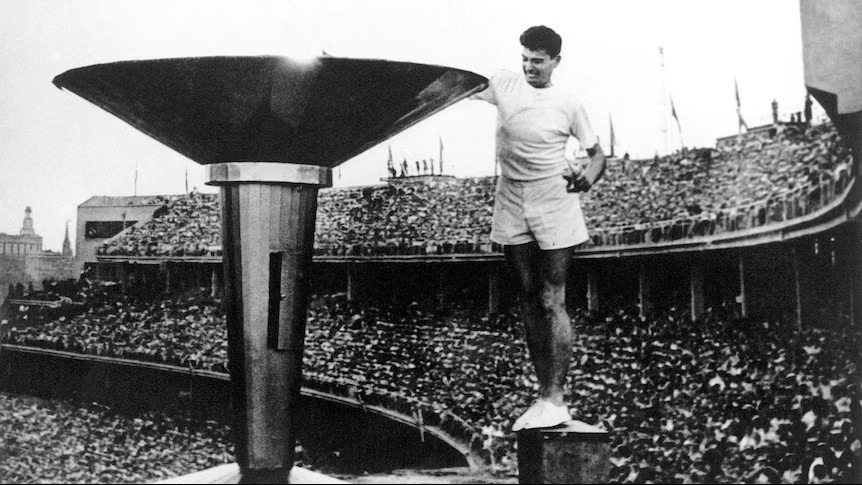H
onoured as a Member of the Wall of Sporting Legends on 28 November 2015
Born into a sporting family in Melbourne, on February 21 1937, Ronald William Clarke, would run a very different athletic path, to his father Tom and brother Jack, who both played senior football for Essendon in the VFL.
Clarke made his mark, in middle distance running and was arguably Australia’s greatest. But he achieved so much more – an author of seven books, a philanthropist, a former Gold Coast Mayor, fitness advocate and champion of charity, who embraced life, seizing every day until the very end.
Clarke was revered internationally in the 1960s for holding every world record from two miles to 20km - a feat unmatched by any other athlete to this day. He ran an astonishing 17 official world records and was rated by many as the greatest distance runner of his era.
He was also a part of a very famous incident, which is regarded one of the greatest moments of world sportsmanship and resulted in a larger-than-life commemorative sculpture called ‘ Sportsmanship', erected directly across the road from Olympic Park in Melbourne.
In the 1956 Australian championships, he was leading halfway through the mile when he clipped the heel of NSW runner Alec Henderson. Clarke was sprawled on the track in front of world record holder John Landy whose attempt to hurdle him resulted in a slice to Clarke’s arm from a spike.
Landy stopped, went back, helped Clarke to his feet and apologised. Clarke said he was fine and urged him to keep going. Landy, by then 30 yards behind, resumed the chase and, in a tremendous burst of speed, caught the rest of the field and won. It was thought had he not stopped, Landy would have surely set a world record.
At the 1964 Tokyo Olympic Games Clarke won bronze in the 10,000m behind American Billy Mills and Tunisia’s Mohammed Gammoudi.
In 1965, at the peak of his career, Clarke competed 18 times in eight countries during a 44-day tour of Europe. He set 12 world records, nine of which were established within an incredible 21 days.
By the 1968 Mexico Olympic Games, Clarke had already set a world record of 28 minutes 15.6 seconds for the 10,000m and was tipped to win the event on the first day of competition.
But the stadium was more than 2,000m above sea level and the low oxygen level inevitably caused problems for athletes not used to competing at high altitudes. Of the 37 starters in the event, seven were mountain men from countries such as Kenya, Ethiopia and Mexico (who went on to fill five of the first 10 places).
Clarke's plan was to stay with the leaders and then press forward over the final 2,000m. When he tried to do so, however, he felt as if he had run into a brick wall. He staggered on, grey and almost unconscious, to finish sixth, but collapsed at the line.
After 60 litres of oxygen and an anxious hour for the team doctor and spectators, many of whom were in tears fearing the worst, Clarke recovered consciousness. 13 years later it was discovered that he had ruptured a valve controlling his heart muscle, leaving him with a weakened heart that later required surgery.
While Clarke’s quest for Olympic gold eluded him, a remarkable gesture by fellow champion Emil Zatopek to give Clarke one of his own four Olympic gold medals, said much of the respect those in the athletic world held for him.
Zatopek handed Clarke a package at Prague airport saying: “Look after this. You deserve it.” Inside was the gold medal Zatopek won for the 10,000 metres at the 1952 Helsinki Olympics, reducing Clarke to tears when he opened the parcel at the airport restroom.
Clarke’s career spanned three Commonwealth Games – Perth 1962, Kingston 1966 and Edinburgh in 1970 – producing four silver medals and two Olympic Games – 1964 Tokyo where he won one bronze medal and 1968 Mexico.
After retiring from the track in 1970, Clarke, a chartered accountant, introduced brand names such as Adidas and Nike to Australia. He set up a chain of gymnasiums and published a series of books about sport, while he and his wife Helen raised three children Marcus, Monique and Nic’.
On 15 March 2006, he was one of the final four runners who carried the Queen's Baton around the MCG during the Melbourne 2006 Commonwealth Games Opening Ceremony.
In his dual capacities as Mayor of the City of Gold Coast and as a world-recognised Australian running legend, he was an integral member of the successful Gold Coast 2018 Commonwealth Games Bid team.
He was a presenter of the winning Bid Book to a special Commonwealth Games Federation executive committee meeting in Kuala Lumpur in May 2011 and in November that year he travelled to St Kitts and Nevis when the Gold Coast was announced Host City for the 21st Commonwealth Games.
Clarke won widespread admiration for his philanthropy, which included donating part of his mayoral salary to charity and setting up a bus service to transport cancer patients to hospital. It was named Monique’s Bus, after his daughter who tragically lost her battle with breast cancer in 2009.
Clarke will forever be remembered for being the final torchbearer to light the Cauldron at the 1956 Melbourne Olympic Games. But those closest to him will remember his passion for sport, the dignity with which he carried himself on and off the track and, most of all, his absolute dedication to his family.
